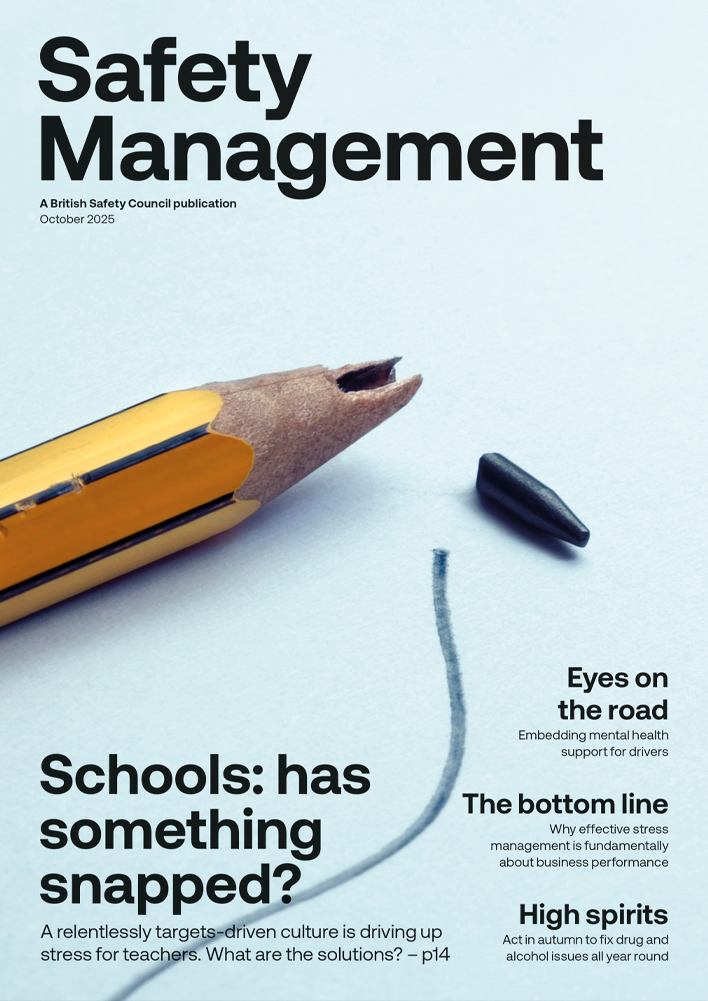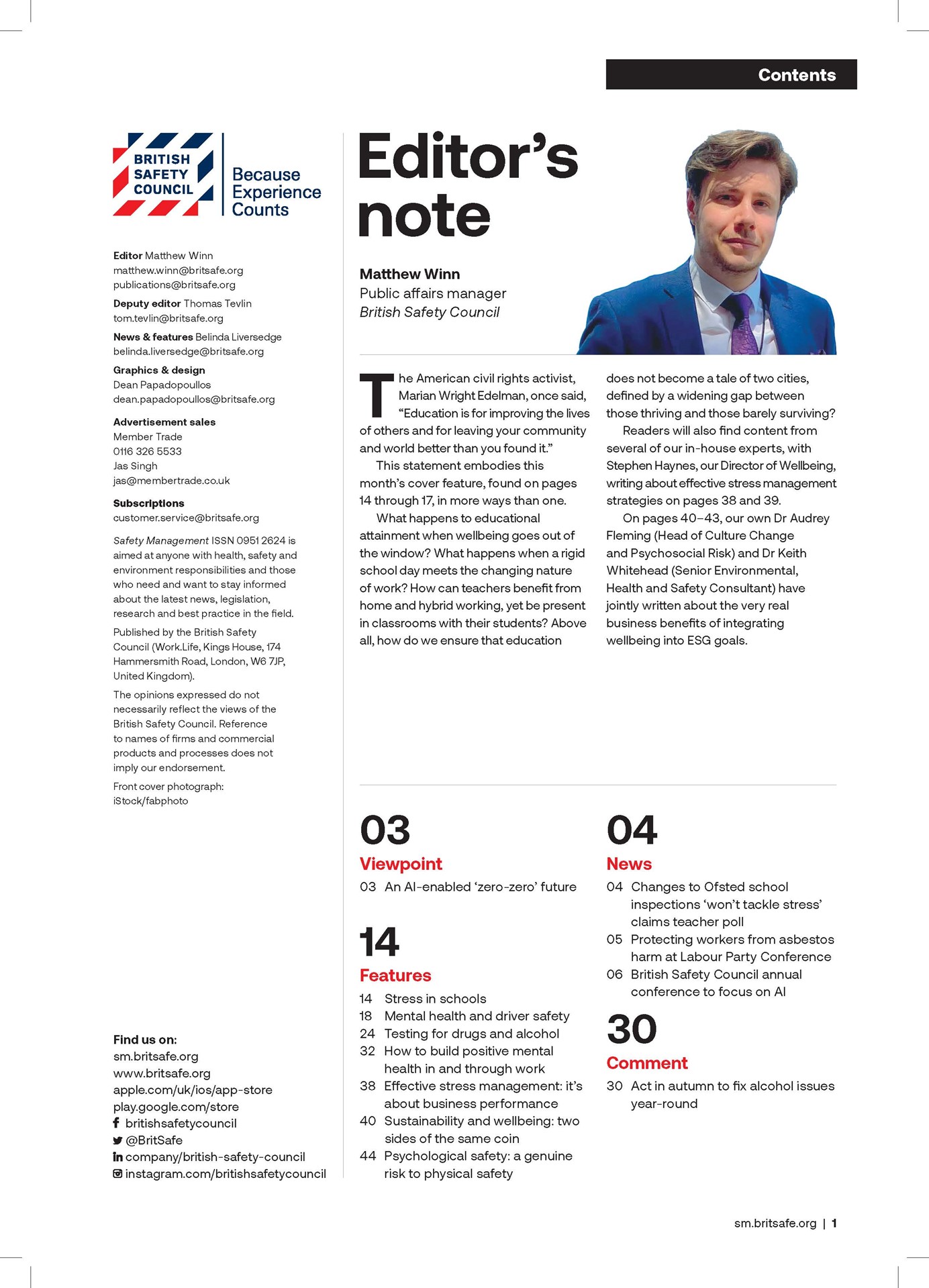The title of this comment, a statement from Professor Dame Carol Black, the government advisor on health and work, should be displayed prominently at every business.
Opinion
You can’t be safe if you’re not healthy
The link between both the health and safety of employees cannot be overstated, as investing in staff wellbeing has shown to improve productivity by up to 25 per cent. This doesn’t include added value to a business from higher performance, reduced sickness absence or better staff retention. We must acknowledge, however, that longer hours don’t always translate into increased achievement.
Quite simply, an employee operating at 100 per cent efficiency for five hours is better than them completing an eight-hour shift at just 50 per cent. Individual happiness, physical wellbeing and positive mental health are all major contributory factors in the overall health and profitability of a business, be it a one-man band or a workforce of thousands.
In our experience within the logistics, grocery and warehousing sectors, the exponential growth in online shopping has resulted in a significant rise in work-related injuries. The facts are stark. Improper manual handling costs millions each year with more than 100,000 manual handling injuries recorded, 2,000 of those classed as severe.

An employee operating at 100 per cent efficiency for five hours is better than them completing an eight-hour shift at just 50 per cent
Musculoskeletal injuries account for over 40 per cent of all work-related sickness and data from the Health and Safety Executive (HSE) shows that around 8.8 million working days were lost to this type of injury during 2015–16, mainly caused by poor manual handling or ergonomic practices. Using an average sick pay amount of £17.69 per day, researchers calculated the total cost to firms of around £154 million.
Reducing injuries but also labour costs associated with home delivery are two major challenges currently faced by supermarkets and retailers. In addressing these, the use of specially designed technology, such as powered lightweight stair climbers, is one example where safe and cost-effective goods handling solutions are generating positive return on investment and it’s encouraging to see this approach is gaining traction in the fast-moving goods market.
Similarly, innovative wearable devices which employ artificial intelligence (AI) to identify hazardous actions, by continuously measuring movement, frequency and forces on the body, are now being trialled. A major benefit of AI-based solutions, is that data collected can encourage employees to self-manage their own wellbeing, while management can use it to implement wider business improvements.
In our experience of supporting customers with such technology, operatives can learn and embed new movement techniques into their working lives, reduce the risk of injury and help create a culture of safety and productivity, which adds significant value to the business.
It goes without saying that employers have a responsibility to assess and manage the risks posed to their employees from manual handling, as covered by the Manual Handling Operations Regulations 1992. Failure to comply leaves a business and its directors at risk of prosecution from HSE, potential fall-out from financial penalties and reputational damage.
From a mental health perspective, the misconceived notion that working longer hours boosts productivity has had the opposite effect. According to a report by the Lancet Commission, more than 15 million days were lost to absence arising from anxiety, stress and depression in 2018. The report stated that mental health disorders are on the rise in every country in the world, which could cost the global economy up to $16 trillion by 2030 if not addressed urgently.
The Stevenson/Farmer review Thriving at Work published in 2017 claimed that workplace mental health issues costs UK employers a staggering £42 billion a year and estimates that 15 per cent of workers have an existing mental health condition.
Again, technology has a role to play in tackling but also understanding this issue better, which is fast becoming a corporate epidemic. Designed with carefully researched algorithms, the use of online mental health diagnostic tools, for example, have shown to be effective in quickly identifying vulnerable team members, so they can be supported appropriately.
In our view, improving overall workplace wellbeing requires a holistic, consultative approach, which is managed both discreetly and empathetically. For a workplace to be an engaging, rewarding and ultimately happy place to spend so much of our lives, it is up to every business to take a proactive stance on employee safety and wellbeing.
Above all, an individual’s happiness, productivity, performance and retention are all linked to their physical and mental health, so in looking after people properly, we should think of it as an investment, not a cost.
Graham Sharp is managing director at Stanley
OPINION

Don’t lose autism in the neurodiversity wave – why targeted reform is essential
By Rt Hon Sir Robert Buckland KBE KC on 03 December 2025
Autistic adults have waited too long for meaningful reform. They have shared their experiences and expertise. Now they deserve action, accountability, and transformation.

Inclusion saves lives: embedding equality, diversity and inclusion (EDI) into global occupational safety and health
By Umer Changaiz, CMIOSH on 03 December 2025

Work-related road risk – steering clear of danger
By Ben Pepper, CL Medilaw on 30 October 2025
Each day across the UK, millions of employees take to the roads as part of their working lives. Whether delivering parcels, attending client meetings or riding bicycles between jobs, road use plays a vital role in keeping businesses going. While the general health and safety landscape has evolved significantly over recent decades, work-related road risk (‘WRRR’) remains an area that is too often overlooked by employers.



